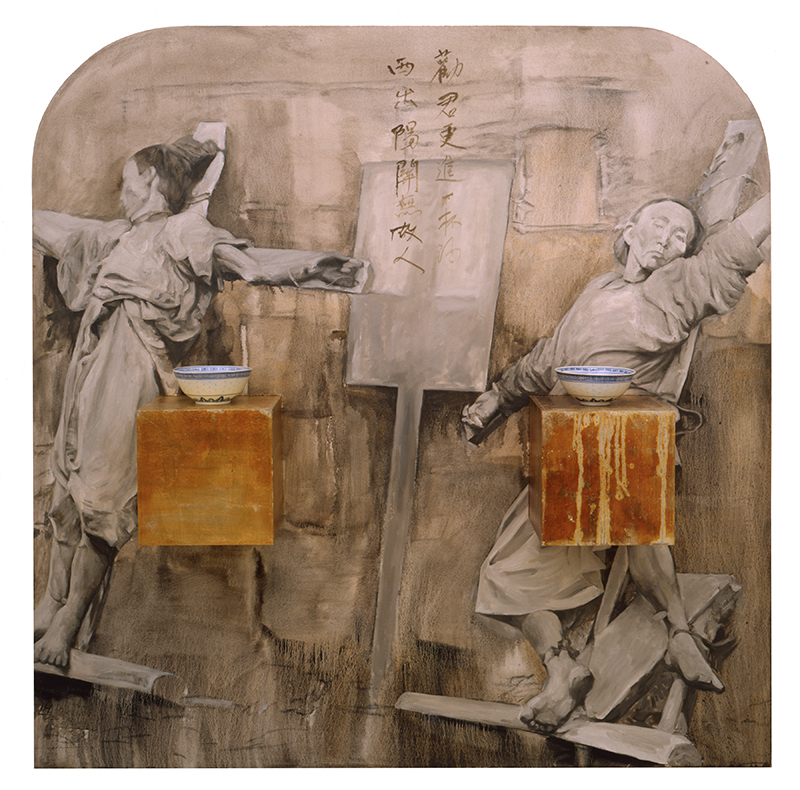Object of the Month: Hung Liu, "Western Pass"
By Bowdoin College Museum of Art
Western Pass, 1990, oil with silverleaf on wood, ceramics on canvas, by Hung Liu, Chinese American, 1948–2021. Museum Purchase, Lloyd O. and Marjorie Strong Coulter Fund, Bowdoin College Museum of Art. 2021.53
Hung Liu’s Western Pass (1990) is a monochromatically painted scene of two crucifixes with two bodies, who are presumably Chinese, combined with a classical Chinese poem inscription and two bowls that jut out from the canvas. Using Liu’s signature linseed oil technique, the two figures seem to be ghost-like and almost transparent. The artwork is a haunting one, as the viewer witnesses two nameless and lifeless figures during their execution.
Hung Liu (1948–2021) was a Chinese American artist who grew up under the Cultural Revolution in China and immigrated to the United States in 1984, graduating from the MFA program at the University of California, San Diego. Western Pass addresses her complicated feelings as an immigrant both towards her country of origin, China, and her adopted country, the United States. This work connects the Chinese American artist back to her native China in the aftermath of the 1989 Tiananmen Square Massacre. The central image of the two bodies harkens back to the Boxer Rebellion (1899–1901), a Chinese-led rebellion during the Qing Dynasty against encroaching Western influence in China. The central image of the two figures was painted after a historic photograph, which was taken by a British botanist who was present in China during the Rebellion.
What first drew me first to the work was seeing the two bowls together with the scene from the Boxer Rebellion. By placing a scene from the Boxer Rebellion into the context of Asian-American experiences, Liu addresses the nuances of Asian-American identity and larger questions of power and empire. It is worth unpacking the complicated history of the Boxer Rebellion to fully understand Western Pass. With increasing spheres of cultural, political, and religious influence by Western countries in China, the “Boxers,” a group of Chinese anti-imperialists, led a rebellion for Chinese autonomy at the turn of the twentieth century. However, the Rebellion is often told and interpreted from a Western perspective as an event in which Westerners were the primary victims. While the painting captures the gruesome and unfortunate violence of the Boxer Rebellion, the inclusion of the poem adds a more tender and somewhat mournful note to the piece. The poem reads “My friend, please empty one more drink with me… West of Yang Gate, no more old friends to see.” While written during the Tang Dynasty, the poem also speaks to Hung Liu’s experience of leaving her old life in China behind and beginning her life in the West.
The two bowls remind me of an offering or an altar to one’s ancestors, a common feature in East Asian culture. These particular bowls were likely purchased from San Francisco’s Chinatown, Liu’s adopted city.
This artwork is especially interesting in the context of Asian-American history and the history of American (and to a greater extent, Western) empire building. In the spring semester of 2022, I took a class with Associate Professor of History and Environmental Studies Connie Chiang titled “Asian-American History, 1850 to the Present.” Before we started with the chronology of major events in the history of Asian Americans, we started with a theoretical approach toward Asian-American history, going over important themes such as Orientalism and Empire. When the United States finished manifesting its destiny across the North American continent and reached the Pacific coast in the nineteenth century, they reached their arm across the Pacific Ocean and found themselves intervening in the affairs of Asia. When we talk about Asians in America, we must therefore realize that Asians are in America due to the processes of American empire building. In the case of China and Chinese Americans, the first large wave of Chinese immigrants to the United States were from Guangzhou, a major trading port city in southern China, and the surrounding areas. This difficult history of Asians being brought to the United States under fraught circumstances connects to Hung Liu’s work in her identity as an Asian-American artist and her own complicated feelings about her native land and her adopted home With the inclusion of a scene from the Boxer Rebellion, she is addressing the issue of Western influence in China to remind the audience of this historical context.
As an artist who had left China to practice in the United States, she tries to reconcile her identity in connection to both places. As a Chinese American artist, her goal in the United States was “to invent a way of allowing myself to practice as a Chinese artist outside of a Chinese culture.” With stark contrasts between East and West in Western Pass, Hung Liu does not give a complete or straightforward answer to her experiences, but rather brings up larger, nuanced questions about the connection between empires and immigration.
Joseph Park ’25Academic Year Student Education Assistant
Bowdoin College Museum of Art